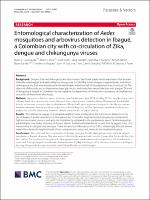| dc.creator | Carrasquilla, María Cristina | |
| dc.creator | Ortiz, Mario Iván | |
| dc.creator | Miretti, Marcos Mateo | |
| dc.creator | Rondon, Silvia | |
| dc.creator | Kulkarni, Manisha A. | |
| dc.creator | Talbot, Benoit | |
| dc.creator | Beate, Sander | |
| dc.creator | Vásquez, Heriberto | |
| dc.creator | Cordovez, Juan Manuel | |
| dc.creator | González, Camila | |
| dc.date.accessioned | 2023-08-24T12:21:40Z | |
| dc.date.available | 2023-08-24T12:21:40Z | |
| dc.date.issued | 2021-09-09 | |
| dc.identifier.citation | Carrasquilla, M.C., Ortiz, M.I., Miretti, M.M., Rondon, S., Kulkarni, M.A., Talbot, B.,...Gonzalez, C. (2021). Entomological characterization of aedes mosquitoes and arbovirus detection in Ibagué, a Colombian city with co‑circulation of zika, dengue and chikungunya viruses. Parasites and Vectors. Reino Unido : BioMed Central, 1(14), pp. 1-14. | es_AR |
| dc.identifier.issn | 1756-3305 | |
| dc.identifier.other | CCPI-CNyE-A-143 | |
| dc.identifier.other | 26015 | |
| dc.identifier.uri | https://hdl.handle.net/20.500.12219/5075 | |
| dc.description | Fil: Carrasquilla, María Cristina. Universidad de los Andes; Colombia. | |
| dc.description | Fil: Ortiz, Mario Iván. Universidad de los Andes; Colombia. | |
| dc.description | Fil: Miretti, Marcos Mateo. Consejo Nacional de Investigaciones Científicas y Técnicas. Centro Científico Tecnológico Conicet (Nordeste). Instituto de Biología Subtropical; Argentina. | |
| dc.description | Fil: Miretti, Marcos Mateo. Universidad Nacional de Misiones. Instituto de Biología Subtropical; Argentina. | |
| dc.description | Fil: Rondon, Silvia. Universidad de los Andes; Colombia. | |
| dc.description | Fil: Kulkarni, Manisha A. University of Ottawa; Canadá. | |
| dc.description | Fil: Talbot, Benoit. University of Ottawa; Canadá. | |
| dc.description | Fil: Beate Sander. University Health Network; Canadá. | |
| dc.description | Fil: Vásquez, Heriberto. Secretaría de Salud de Ibagué; Colombia. | |
| dc.description | Fil: Cordovez, Juan Manuel. Universidad de los Andes; Colombia. | |
| dc.description | Fil: González, Camila. Universidad de los Andes; Colombia. | |
| dc.description.abstract | Background: Dengue, Zika and chikungunya are arboviruses of signifcant public health importance that are transmitted by Aedes aegypti and Aedes albopictus mosquitoes. In Colombia, where dengue is hyperendemic, and where chikungunya and Zika were introduced in the last decade, more than half of the population lives in areas at risk. The objective of this study was to characterize Aedes spp. vectors and study their natural infection with dengue, Zika and
chikungunya in Ibagué, a Colombian city and capital of the department of Tolima, with case reports of simultaneous circulation of these three arboviruses.
Methods: Mosquito collections were carried out monthly between June 2018 and May 2019 in neighborhoods with diferent levels of socioeconomic status. We used the non-parametric Friedman, Mann–Whitney and Kruskal–Wal-lis tests to compare mosquito density distributions. We applied logistic regression analyses to identify associations between mosquito density and absence/presence of breeding sites, and the Spearman correlation coefcient to analyze the possible relationship between climatic variables and mosquito density.
Results: We collected Ae. aegypti in all sampled neighborhoods and found for the frst time Ae. albopictus in the city of Ibagué. A greater abundance of mosquitoes was collected in neighborhoods displaying low compared to high socioeconomic status as well as in the intradomicile compared to the peridomestic space. Female mosquitoes predominated over males, and most of the test females had fed on human blood. In total, four Ae. aegypti pools (3%) were positive for dengue virus (serotype 1) and one pool for chikungunya virus (0.8%). Interestingly, infected females were only collected in neighborhoods of low socioeconomic status, and mostly in the intradomicile space.
Conclusions: We confrmed the co-circulation of dengue (serotype 1) and chikungunya viruses in the Ae. aegypti population in Ibagué. However, Zika virus was not detected in any mosquito sample, 3 years after its introduction into
the country. The positivity for dengue and chikungunya viruses, predominance of mosquitoes in the intradomicile space and the high proportion of females fed on humans highlight the high risk for arbovirus transmission in Ibagué, but may also provide an opportunity for establishing efective control strategies. | es_AR |
| dc.format | application/pdf | |
| dc.format.extent | 2.6 MB | |
| dc.language.iso | eng | es_AR |
| dc.publisher | BioMed Central | es_AR |
| dc.relation | info:eu-repo/semantics/altIdentifier/hdl/http://hdl.handle.net/11336/156757 | |
| dc.relation | info:eu-repo/semantics/altIdentifier/doi/https://doi.org/10.1186/s13071-021-04908-x | |
| dc.rights | info:eu-repo/semantics/openAccess | |
| dc.subject | Dengue | es_AR |
| dc.subject | Zika | es_AR |
| dc.subject | Chikungunya | es_AR |
| dc.subject | Aedes aegypti | es_AR |
| dc.subject | Aedes albopictus | es_AR |
| dc.subject | Colombia | es_AR |
| dc.title | Entomological characterization of aedes mosquitoes and arbovirus detection in Ibagué, a Colombian city with co‑circulation of zika, dengue and chikungunya viruses | es_AR |
| dc.type | info:eu-repo/semantics/article | es_AR |
| dc.type | info:ar-repo/semantics/artículo | |
| dc.type | info:eu-repo/semantics/publishedVersion | |



